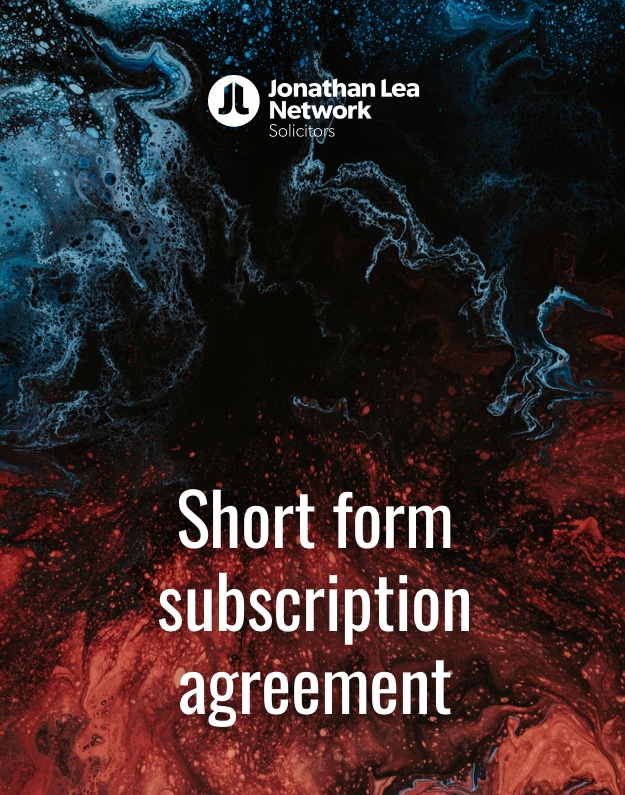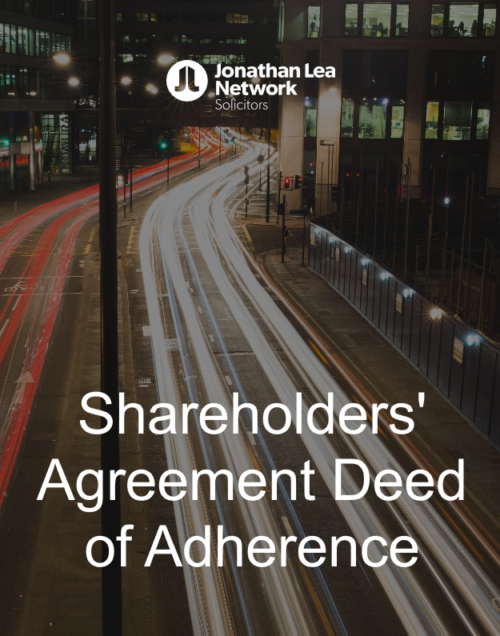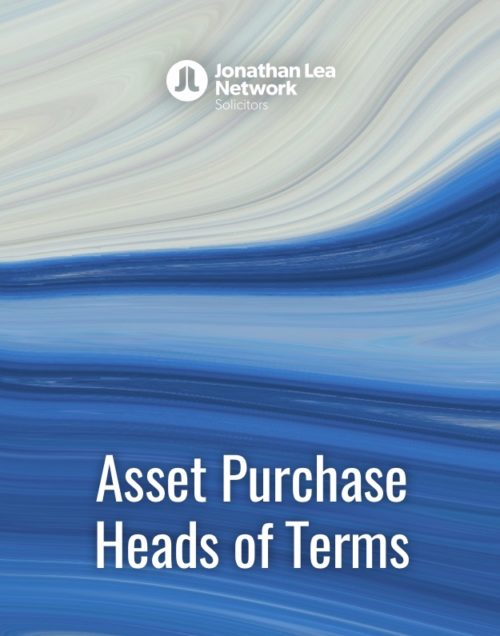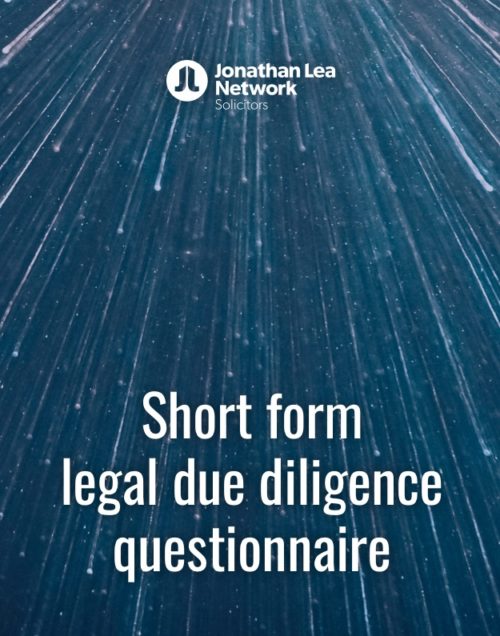Short form subscription agreement
£12.99
This product constitutes an easily adaptable short form subscription agreement (sometimes referred to as an investment agreement) which can be used to facilitate early round venture capital investments in a private limited, UK registered company, together with a set of tailored guidance notes which provide helpful insights as to the template’s contents and aim to explain the key terms of the document.
Further down the page are the guidance notes relating to this template which you will also receive as a separate document when you buy the product.
Guide to the Jonathan Lea Network short form subscription agreement template
This guide aims to set out how to correctly fill-out the subscription/investment agreement template and explain all significant provisions so as to allow you to put into effect a valid and legally binding subscription agreement (sometimes also referred to as an ‘investment agreement’).
Please note that the subscription agreement template provided is a short form version.
This agreement is intended as a template only and must be adapted to the particular circumstances of your case.
Your input is required at the parts of the agreement highlighted in yellow and the wording inside the square brackets which we have included explains clearly the information that should be inserted. You are advised to fill in the wording in square brackets in lower case unless directed otherwise. Any figures should be entered in numerical form. The brackets should be removed after the amendments are made (so as to produce a ‘final form’ version of the agreement).
Clause breakdown
Parties
The registered company name, office and number of the company and the investor’s name and their residential address should be inserted accordingly. If a company is trading under a name other than the registered company name, the words “trading as [insert trading name]” may be inserted just after the relevant party’s address.
The founders of the company should also be included as parties to the subscription agreement and this part of the template can be adapted depending on how many founders there are – i.e. if there is more than one founder then at 3) you can list as many as you like to reflect this. If there is only one founder then the definition of “Founders” should be amended to “Founder” and the rest of the template should be amended accordingly.
If a company is registered in a place other than England and Wales, the words ‘England and Wales’ should be replaced with the relevant country of registration.
Background
Background clauses (also known as ‘recitals’) are intended to explain the background of, and purpose to, the agreement. These are not intended to be, nor do they constitute, substantive provisions and as such are not binding unless they are specifically stated to be incorporated in the main body of the agreement.
Under this section on page 2, you can add additional sub-clauses to set out / explain any subdivisions of share capital or allotment of shares that may be taking place.
For example, the new clauses could read as follows: “Immediately before issuing shares to the Investor the Company will subdivide its share capital of 100 ordinary shares with a nominal value of £1 each by 10,000 to instead create 1,000,000 ordinary shares of nominal value £0.0001 each, all of which shall be fully paid”.
There would then need to be another sub-clause below that which reads: “The subdivision will be effected by the Company passing a shareholders resolution and filing an SH02 statement of capital at Companies House”.
Clause 1 (Interpretation)
Clause 1.1 sets out the definitions that will apply throughout the subscription agreement.
Clause 2 (Subscription application)
This clause sets out the shares to be subscribed for by the investor. Our template subscription agreement contemplates that the investor will subscribe for the same class of shares as the existing shareholders.
It may be the case that the investor wants to acquire a different class of shares to the existing shareholders (for example shares that differentiate as to payments of dividends and other distributions and priority on a return of capital). The investor may require a new class of ordinary share to be issued to them or maybe even preference shares. If this is the scenario, it may be appropriate to include additional clauses setting this out and providing for the creation of a new class of shares (perhaps as a pre-condition / deliverable of the transaction).
The application form referred to at part 1 of schedule 2 sets out the investor’s details and indicates the number of shares being subscribed for and the total subscription monies due.
The word “warrants” in clause 2.3 means that each party to the agreement is providing a warranty (i.e. a contractual promise) that the circumstances set out in sub-clauses (a), (b) and (c) are true and accurate as at the date of the agreement.
Clause 3 (Payment and completion)
In clause 3.1, confirming that completion will take place remotely avoids the need for the parties to meet in one location and have the agreement signed and for all other relevant completion deliverables to take place.
The remainder of clause 3.1 sets out clearly the investor’s obligation to transfer the subscription monies to the company’s bank account (i.e. to pay for the subscription shares) and to notify the founders once such transfer has been made.
This template subscription agreement is not conditional and so the subscription will complete simultaneously with execution.
Clause 3.3 details the procedure that will be followed upon completion of the subscription.
Clause 3.4 will need to be amended if the investor is to pay the subscription price in a currency other than pound sterling.
Clause 3.5 has been included so as to give the investors a deadline by which they must send completed application forms and the subscription monies to the company. This just ensures that the monies can be raised in an expedient fashion and that there are no undue delays.
Clause 3.6 covers the company and the founders from being held liable to pay any transmission costs in relation to the payment of the subscription monies by the investor. This clause confirms that the investor is the party liable for any such transmission costs.
Clause 4 (Acknowledgement)
This clause protects the company and the founders from any claim by the investor should the company later go into insolvency / liquidation (meaning that the investor loses their investment).
Clause 4.1 provides that the investor acknowledges the degree of risk involved and that the investor has (or should have) obtained all such financial, legal and other advice as they consider necessary with regards to the investment in the company.
Clause 4.2 confirms that the investor is subscribing for the subscription shares subject to the terms of the subscription agreement only, and not on the basis of any other information.
Clause 4.3 provides additional protection to the company by stating that the investor acknowledges that any projections and forecasts as well as any statements relating to expectations regarding future events or the possible future performance of the company that have been provided by the company do not amount to representations or assurances that such projections or forecasts are correct or that the stated objectives of the company will be achieved.
This protects the founders and the company from the situation where the company fails to achieve projected sales targets or fails to meet any other company objectives that were told to the investor. This clause prevents the investor for bringing a breach of contract claim where forecasts do not materialise and objectives are not achieved.
Clause 5 (Warranties)
This template subscription agreement does not provide for comprehensive warranty protections because it is designed for a straightforward investment without significant control rights being offered to the investor.
The warranties set out in this clause give the investor comfort in respect of capacity and authorisation, and certain factual information relating to the company and the shares held by the existing shareholders.
As mentioned above, warranties are contractual promises that shows the warrantor (i.e. the company) promising that the circumstances outlined in the warranties are correct and that all warranties given are true, accurate and not misleading as at the date of the agreement.
You should read each of the warranties set out in this clause carefully, and if you feel that you are unable to provide a warranty then it should be removed from the agreement. For example, if your company has subsidiaries, then warranty 5.3(c) will need to be amended so that it states, for example: “the Company has [INSERT NUMBER] subsidiaries, being [INSERT SUBSIDIARY NAME], registered in [England and Wales] with company number [INSERT COMPANY NUMBER] and whose registered office is at [INSERT REGISTERED OFFICE ADDRESS]” – this should be repeated for each subsidiary if there is more than one.
Clause 6 (Dividend policy)
This clause confirms that the investor will not be entitled to dividends and that there is no dividend policy in place as such. All parties to the agreement confirm that, as the company’s intention is to build long term capital value and re-invest as much cash flow as possible into the business, the company will not be in a position to declare any dividends to be distributed to the shareholders for several years.
This clause avoids the argument by an investor that they are entitled under the subscription agreement to a dividend payment.
Clause 7 (Confidentiality)
This clause provides details of the kinds of information that will not be considered to be confidential information, for example information that is:
– in the public domain (other than through the wrongful disclose by any party to the agreement;
– lawfully available from a third party (such as a regulatory or governmental body) which was not under any confidentiality obligation prior to such disclosure; and
– required by law / regulation to be disclosed.
The clause prevents the parties to this agreement from disclosing to any third party (except a party’s professional advisers) any of the information set out in clauses 7.1(a) – (c).
Clause 7.2 prevents any party to the agreement from making any public announcement / press release concerning / relating to the agreement.
Clause 7.3 sets out the circumstances in which a party to the agreement may make a public announcement relating to the agreement, for example where such an announcement is required by law.
Clause 8 (Assignment)
This clause simply provides that the agreement is personal to the parties and that neither party can assign any of its rights, or transfer, sub-contract or delegate any of its obligations. The clause also provides that no party can charge or deal in any other manner with the agreement or any of its rights or obligations.
Clause 8.2 confirms that any such any such action taken by either party in contravention of clause 8.1 will be ineffective.
Clause 9 (FCA compliance)
Clause 9.1 confirms that a relevant exemption applies and that the agreement has not been approved by a FSMA (Financial Services and Markets Act 2000) person (as is otherwise required under section 21 of FSMA).
Clause 9.2 states that the agreement is being solely issued and directed at the following categories of individual:
– persons whom the company reasonably believes to have professional experience in matters relating to investments and investment professionals;
– certified high net worth individuals;
– high net worth companies, unincorporated associations or high value trusts;
– certified sophisticated investors; and
– self-certificated sophisticated investors
These categories of individual are deemed to be ‘appropriate investors’.
Clause 9.3 applies to individuals that are not appropriate investors. This clause therefore attempts to explain the risks involved with investing capital in a business and requires that the investor (not being an appropriate investor) reads and understands the risks (and enters into the agreement in full knowledge and acceptance of such risks). Even if the investor fits into the category of an appropriate investor, it is still advisable that they read such risks and this is why these have been included within the agreement.
Clause 9.4 sets out further warranties / representations made this time by the investor to the company.
Clause 10 (Third party rights)
This clause seeks to prevent any third parties from inadvertently being given the right to enforce the agreement. It makes clear that, in general, the provisions of the agreement are personal to the parties and do not confer any benefit on third parties.
The common law doctrine of privity of contract provides that the only persons entitled to the benefit of a contract, and to enforce rights under it, are those persons who are parties to the contract. However, this doctrine has been modified by the statutory rights conferred on third parties by the Contracts (Rights of Third Parties) Act 1999 (referred to in this section as the “Act”). The Act made it possible for a non-party to enforce a contractual term in its favour, which had until then been achievable only by indirect routes.
Subject to contrary provision, where the Act applies:
– If a third party would benefit from enforcing a contractual term, it may have the right to do so. Note that the Act can only operate to confer rights and cannot transfer obligations.
– If the contract creates a third party right under the Act, the parties’ freedom to vary or rescind the contract is limited.
If these effects are not desired, express wording is required to exclude them – hence the inclusion of this clause.
Clause 11 (Agreement survives completion)
This clause is intended to prevent the application of the doctrine of merger of a contract. Under this doctrine, on completion of an executory contract, the contract will merge with an implementing deed to the extent that the contract and deed cover the same ground. As there is generally no implementing deed in a venture capital investment, the doctrine of merger is unlikely to be relevant. However, to address the possibility that the courts could apply the doctrine by analogy to an investment, it is prudent to include an express provision preserving the enforceability of the agreement following completion.
Clause 12 (Status of agreement)
It is common for the subscription agreement to be expressed to be the prevailing contract between the parties in the event of any conflict with the articles of association (i.e. clause 12.2). This ensures that the remedy of an injunction will usually be available to ensure that each shareholder takes the necessary voting action when voting as a shareholder of the company to give effect to its terms.
As the company is a party to the agreement, the obligations in this clause apply to the shareholders and not all parties, to avoid the company being bound by a provision that would risk being an unlawful fetter on its statutory powers.
If the subscription agreement covers some of the matters as the articles of association, a provision to the effect that the investment agreement should take precedence over the articles on its own might indicate that the agreement should prevail in place of the articles and should therefore be registered under sections 29 and 30 of the Companies Act 2006. As a result, this provision is typically couples with a provision that the parties will exercise their powers to amend any conflicting provisions in the articles (i.e. clauses 12.1 and 12.3).
Clause 13 (Severance)
Parties may subsequently find that their agreement contains provisions which are illegal, with the result that all or part of the contract could be void or unenforceable. The purpose of a severance clause is to make clear that, under such circumstances, the parties intend the agreement to survive by severing (i.e. removing) the offending provisions from the rest of the agreement.
The doctrine of severance is likely to be applied by the courts whether or not there is an express severance provision. Nevertheless, in practice inclusion of an express clause is advisable because:
– If a clause is not used, the application of the doctrine of severance by the courts could be more restrictive than under an express clause.
– The inclusion of a clause gives some moral weight to how the position should be resolved between the parties, if provisions in the contract prove to be invalid or illegal.
As a general rule, the courts will not make a new contract for the parties, whether by rewriting any provision in an existing contract or by altering its basic nature. Nor is it possible for the contract to confer on the court any additional power to re-write a clause or to reduce either its geographical scope or the period for which it is effective.
Clause 14 (Variation and waiver)
Clause 14.1 (Variation clause) – This clause aims to exclude the possibility of informal, and perhaps inadvertent, oral variations being made to the agreement by requiring the parties to follow a prescribed procedure to vary the agreement. Given that our template agreement is structured and executed as a deed (the rationale behind this is explained below), it is best practice to require any variations to also be executed as a deed (although this is not necessarily a legal requirement).
It is worth noting that clause 14.1 has been drafted on the basis that the unanimous agreement of all parties (i.e. the company, the investor and the founders) will be required in order to vary the agreement. In practice, particularly some years after the initial investment, unanimity may not be feasible, for example if the company’s shareholder base is more diverse as a result of permitted transfers. However, changes consented to by all parties will be less susceptible to challenge.
Clause 14.2 (Waiver clause) – The purpose behind this clause is to ensure that, if a party agrees to waive its rights (whether under the agreement or at common law) in respect of the other party’s breach, the waiver is only effective if made in writing. The second part of the clause deals with waivers for future breaches, so that if a party agrees in writing to waive one breach, that waiver does not apply to future circumstances.
Clause 14.3 (Failure or delay in exercising rights clause) – This clause is the most common form of no waiver clause. It covers the innocent party’s failure or delay in asserting its rights (both contractual and common law). The common law doctrine of laches may operate to restrict or prevent a party from enforcing its rights if it delays in taking action to do so. This clause aims to prevent this from happening. Additionally, this clause seeks to ensure, by way of example, that a decision by the investor not to pursue a particular warranty claim will not prejudice its ability to pursue any subsequent claims.
Clause 14.4 (Waiver of rights in relation to one person clause) – This clause refers to “persons” instead of “parties” to deal with situations in which third parties are granted rights under the agreement.
Clause 15 (Costs)
Unless a contract expressly states otherwise, each party bears the costs it incurs in negotiating and performing the agreement. If you intend for each party to the agreement to pay its own costs and expenses, you can omit including this clause, although it is advisable that a clause to that effect would be useful to rebut any argument that one party had agreed to pay some or all of the costs of another party.
It is, however, common in practice for venture capital investors to require the company to meet the investor’s transaction costs. An example clause that you could use in such a situation could read:
“At Completion, the Company shall pay all [reasonable] legal, accounting and due diligence fees and disbursements of the Investor in relation to the negotiation, preparation, execution and performance of this Agreement (and any documents referred to in it) [up to a maximum amount of £[AMOUNT] [plus VAT]]”.
The template clause set out above which sets out such an obligation is widely drafted. It provides that the company will bear all legal, accounting and due diligence fees and expenses not only in relation to the agreement, but also in relation to every other document referred to in it.
While the company is unlikely to succeed in resisting this obligation (given the difference in bargaining power between the company and the venture capital investor), it should seek to cap the amount it may be required to pay. It should also consider whether to restrict the obligation to paying only the investor’s reasonable fees and/or limiting the scope of the fees it will pay. An alternative is to allow the investor to deduct these amounts directly from the amounts that it is due to pay for the subscription shares at completion.
Clause 15 confirms that the parties to the agreement are left to pay their own costs and expenses.
Clause 16 (Entire agreement)
This clause seeks to prevent the parties from being liable for any statements or representations (including pre-contractual representations) except as expressly set out in the agreement or documents referred to in the agreement.
The clause is an exclusion clause so is likely to be construed/interpreted against the person seeking to rely on it. If there are any side letters or ancillary documents to the agreement (which often appear just before signing), this clause may need to be amended.
Clause 17 (Further assurance)
This clause seeks to cover any omissions in the agreement that have not been noticed before signing and which, if unremedied, would change the way the agreement was intended to work. Although we have taken all efforts to ensure that the agreement specifies everything the parties must do in order to complete the investment, this clause has been included as a matter of good practice.
This clause requires the parties to carry out unspecified further acts necessary to give effect to the agreement. Although it may not be clear exactly what action the clause requires, it can add another ground for demanding the action needed, and may therefore be of some practical use in encouraging the other side to co-operate in carrying out the agreement.
Clause 18 (No partnership or agency)
This clause has two different elements: the first element is intended to prevent an agency, partnership or joint venture relationship arising between the parties. The second element is intended to prevent an undisclosed principal situation.
The principal object of a no partnership or agency clause is to exclude the risk of an agreement creating an unwanted partnership or agency relationship between the parties. This clause also attempts to exclude a joint venture agreement from being implied where this is not the parties’ intention. Creating such a relationship may have unfortunate tax consequences, and may result in one party being bound by another in relation to third parties in ways not contemplated by the agreement, or in becoming liable for the other’s acts and omissions.
A further reason for wanting to exclude a partnership or agency relationship is that partners in a partnership owe fiduciary duties to each other, and agents owe fiduciary duties to their principals. Contracting parties will usually wish to exclude implied duties of this ilk.
In certain jurisdictions, a similar authority to bind fellow parties may be imputed between the parties to a joint venture. Therefore, if your situation involves one or more parties incorporated or resident outside England and Wales, expressly exclude a joint venture relationship.
A no partnership or agency clause will effectively exclude any implied authority of one party to the agreement to bind the other, and the duties which exist between partners. However, such a clause may not be effective against third parties, since the agreement in which it appears will usually be a private matter between the parties, and outsiders will have no notice of its contents. A third party who has no knowledge of the agreement may still be able to claim, under one of the principles relating to ostensible authority, that one party to the contract appeared to be able to commit the other. Any implication of agency arising in favour of a third party is more likely to depend on the conduct of the parties than the terms of any agreement between them.
The law of agency allows a party, while apparently acting on its own behalf, to contract as agent for a principal whose identity and even existence are not revealed. The undisclosed principal can then enforce the contract and may be liable to perform it in addition to the agent. To protect themselves against entering into a contract with an unwelcome undisclosed principal, the parties should state in the agreement that each party is acting on their own behalf and not as agent for an undisclosed principal (i.e. clause 18.2). An express exclusion will generally prevent an undisclosed principal from enforcing the contract.
Clause 19 (Notices)
This clause governs the way notices must be given under the agreement, and the time at which a notice is deemed to be received.
Notice clauses can play an important role as they may determine when (and if) other rights under the agreement are triggered.
Clause 20 (Counterparts and execution)
This clause provides that the parties to the agreement may execute (i.e. sign) separate copies of it, rather than all parties having to sign the exact same copy of the agreement. Using a counterparts clause is advisable for reasons of certainty, and to prevent any argument that the subscription agreement is not binding because it has not been properly executed.
This means that the investor, the founders and an authorised signatory of the company can all download the subscription agreement and sign it remotely without all having to meet and sign the document.
If it is easier in the circumstances for all parties to have a face to face meeting and sign the one agreement, that is fine and in which case the date should be inserted in manuscript on the agreement once all parties have signed the one physical document.
When all of the parties are to sign individual counterparts, when they sign the agreements they should leave them UNDATED, and once all of the counterparts have been signed, the date that the last counterpart was signed should be inserted in manuscript on all of the counterparts (i.e. all counterparts should be dated the same).
Clause 21 (Governing law and jurisdiction)
This clause chooses the law applicable to the contract (the laws of England and Wales) and the jurisdiction to which it is subject (the courts of England and Wales).
Clause 11.1 is the governing law clause which specifies the substantive law to be applied in interpretation of the agreement and any dispute in relation to it.
Clause 11.2 is the jurisdiction clause which specifies the courts that are to have jurisdiction to hear disputes that arise in relation to the agreement.
Schedule 1 (Shareholdings pre and post completion of the investment)
The table included in the table in this schedule sets out clearly the shareholders of the company before and after completion (indicating the number of shares held by each) of the investment.
Below is a simple example of how this table would be completed in the following fictitious scenario:
Shareholder A is the founder of Company X (Shareholder A owns 100 ordinary shares of nominal value £1.00 each in Company X). Two investors, Investor 1 and Investor 2, are to subscribe for shares in Company X and enter into a subscription agreement.
Prior to the completion of the transaction with Investor 1 and Investor 2, the table would therefore be completed as follows:
| Shareholder | Number of Ordinary Shares Pre-Completion | Number of Ordinary Shares Post-Completion |
| Shareholder A | 100 (100%) | |
| Investor 1 | 0 (0%) | |
| Investor 2 | 0 (0%) | |
| TOTAL | 100 |
As part of the transaction Company X is going to subdivide its share capital by a factor of 1,000. This will change its share capital from 100 ordinary shares of nominal value £1.00 each to 100,000 ordinary shares of nominal value £0.001 each (resulting in Shareholder A holding 100,000 ordinary shares of nominal value £0.001 each in the capital of Company X immediately following the subdivision).
Company X will then allot/issue 100,000 new ordinary shares of nominal value £0.001 each (50,000 shares to Investor 1 and 50,000 shares to Investor 2), which will in turn increase Company X’s entire issued share capital to 200,000 ordinary shares of nominal value £0.001 each.
Following the subdivision and allotment/issue of new shares to the incoming investors, Shareholder A will retain a 50% shareholding in Company X, with Investor 1 and Investor 2 receiving a 25% shareholding each. The table would then need to be filled out in the following way (taking into consideration the subdivision):
| Shareholder | Number of Ordinary Shares Pre-Completion | Number of Ordinary Shares Post-Completion |
| Shareholder A | 100 (100%) | 100,000 (50%) |
| Investor 1 | 0 (0%) | 50,000 (25%) |
| Investor 2 | 0 (0%) | 50,000 (25%) |
| TOTAL | 100 | 200,000 |
Schedule 2 (Application form)
This application form sets out the details of the subscription by the investor. The form is self-explanatory and will need to be completed by the investor before the subscription agreement is signed by all of the parties.
Execution page
The agreement will need to be signed by the investor, the founder(s) and an authorised signatory on behalf of the company.









